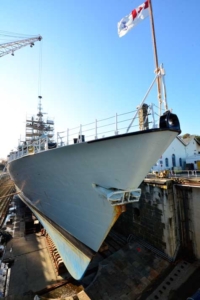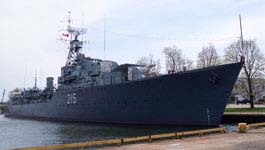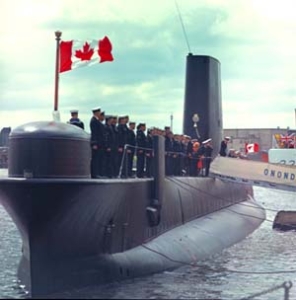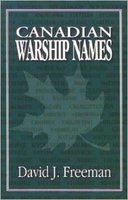Since the early days of sail, seamen have developed terms and expressions peculiar to the environment in which they live and work and the vessels in which they serve. This terminology, which is dear to their hearts, is often misused by non naval personnel, amateur and professional historians and sometimes by other seamen.
What follows is an explanation of some of this terminology as well as selected customs and traditions of the Canadian Naval Service, with examples of proper usage of terms and phrases that relate to Her Majesty’s Canadian Ships.
A “ship” is a vessel designed to travel on the oceans of the world. A “boat” is a small craft carried on board a ship. By naval tradition, a submarine is referred to as a “boat” although she is a fully fledged warship.
A “warship” is a vessel specifically designed, or converted, to be a ship of war. In other words, she is a vessel which by her armament can fight other warships or impose her will on unarmed vessels.
A warship is placed “in commission” by her Commanding Officer designate, when he or she receives an order to do so. This order would originate with the Minister of National Defence. A warship in commission has:
- a “commissioning pennant“;
- an official badge (not a crest);
- a pendant number to wear on her hull;
- a Commanding Officer plus a crew consisting of personnel from mainly naval occupations;
- the right to wear the Maritime Command flag as a Jack and the national flag as an ensign;
- and the right to the title Her Majesty’s Canadian Ship, abbreviated HMCS.
Museum ships like HAIDA and SACKVILLE are not in commission and technically should not employ the title HMCS nor fly a commissioning pennant. They both do so with special permission.
Naval Reserve Divisions, like HMCS TECUMSEH in Calgary, are the last of the Royal Canadian Navy’s “stone frigates” or shore establishments. Each Division is still considered to be a “ship” and is treated as such by the ship’s company. For example, the Commanding Officer of each one is entitled to be “piped” (a form of salute given by a Boatswains’s call), each time he arrives on board or departs.
When her service is finished, a warship is “paid off” by her Commanding Officer. The Jack, Ensign and commissioning pennant are hauled down and the pendant number is often painted over. In addition, her badge and bell should be removed. The term “decommission” is used when referring to Canadian warships.
When a warship pays off, she no longer has the right to use the title HMCS. From this point on, she is referred to in any of the following ways, as appropriate:
- the former (Canadian) destroyer HURON;
- the hulk HURON, a former warship:
- the former warship HURON; OR
- the former HMCS HURON.
In addition, when a warship pays off, she is no longer entitled to her badge. This applies to those former warships sold and used as breakwaters, e.g. the former destroyer GATINEAU H61; as well as those sunk and used as diving sites over the past few years, e.g. the hulk SASKATCHEWAN, 262.
When a warship is sunk by enemy action or by accident, the wreck belongs to the Federal Government forever. The wreck can become a grave site and permission is required to dive on this site. Unless prior written permission is received, no articles or artifacts can be removed from the wreck.
A warship’s name is written in capital letters, as seen on her Battle Honours board, her name (tally) board, her name plate near the stern (if fitted) and prior to 1970, on the cap tally worn by personnel dressed as seamen, e.g. HMCS WINNIPEG. This procedure also applies to Canadian Forces Auxiliary Vessels, e.g. CFAV LAYMORE. A civilian vessel has her name typed in italics, e.g. MV Queen of Nanaimo.
In the title HMCS or HMS, HMAS, etc., the letter H represents one of two pronouns, His or Her. In English, an article such as “the” is never placed in front of a pronoun. Thus: “The HMCS CALGARY…” is incorrect.
Further, one should not refer to the “HMCS HAIDA National Historic Site of Canada.” The reference should read: HMCS HAIDA: A National Historic Site of Canada.
In the same vein, it’s incorrect to say “The HMCS ALPHA Band.” Instead, it is the Band of HMCS ALPHA; and “The HMCS BRAVO Survivor’s Association” should be called the Survivor’s Association of HMCS BRAVO.
When referring to a warship in the United States Navy, however, an article like “the” is acceptable in front of the title as there the word “United” is a verb, e.g. the USS ABRAHAM LINCOLN will visit Victoria next week.
When a warship is undergoing trials prior to her being placed in commission, she is referred to as:
- the soon to commission warship CHARLIE
- the frigate CHARLIE undergoing trials
- the new destroyer/frigate/corvette CHARLIE, soon to commission.
When referring to two or more Canadian warships, the phrase used is “HMC Ships” (not HMCS), e.g. “HMC Ships VANCOUVER and EDMONTON sailed late last night.”
When referring to a single warship, name not known, “One of HMC Ships intercepted.”
A seaman serves “in” a warship or lives or works “on board.” A seaman does not serve “on” a ship. That would be like saying a clerk works “on” the Bonaventure Building in Ottawa, when clearly, not being a construction worker, he/she works “in” that building. A seaman goes “on board” his ship but when leaving the ship, he “goes ashore” or is drafted/posted off.
When departing on a voyage, a warship “sails” or “leaves harbour“; e.g. “REGINA sailed last night.” “HMC Ships WINNIPEG and CALGARY will leave harbour at 0900.”
The names of former warships are perpetuated by new vessels bearing old names, e.g. OTTAWA, fourth of name. She may also be referred to as the fourth OTTAWA.
The use of Roman numerals after the name of a warship e.g. OTTAWA IV, is not to be employed for one very good reason: in naval circles, it is possible (on rare occasions) to have more that one ship of the same name in commission at the same time. To distinguish between them, Roman numerals are used after the name and this suffix becomes part of her official name, e.g. HMCS CHALEUR II [not to be confused with the third CHALEUR, 144 or the fourth CHALEUR, 164]. Other examples from the 1940s are: HMC Ships NADEN, NADEN II, and NADEN III; and in the mid 1970s the tug, CFAV GLENLIVET II.
There are several ways to refer to the first, second, third or fourth vessels:
- OTTAWA H60; OTTAWA H31; OTTAWA 229 and OTTAWA 340;
- OTTAWA, second of name;
- OTTAWA 3rd;
- The fourth [HMCS] OTTAWA.
This information is provided for the guidance of civilian and naval personnel in employing the correct terminology when referring to one of HMC Ships. Hopefully, it can help reduce the number of errors seen in the media, on web sites and in family histories.




 CFB Esquimalt Naval and Military Museum
CFB Esquimalt Naval and Military Museum CFB Esquimalt Naval and Military Museum
CFB Esquimalt Naval and Military Museum CFB Esquimalt Naval and Military Museum
CFB Esquimalt Naval and Military Museum CFB Esquimalt Naval and Military Museum
CFB Esquimalt Naval and Military Museum CFB Esquimalt Naval and Military Museum
CFB Esquimalt Naval and Military Museum